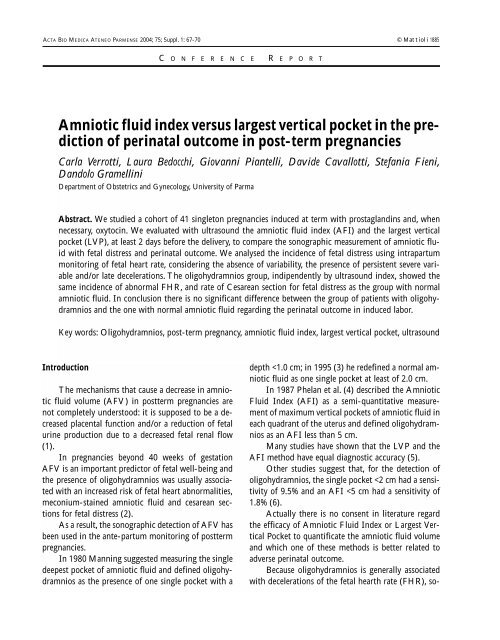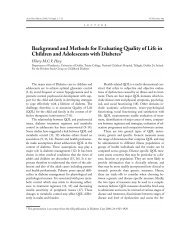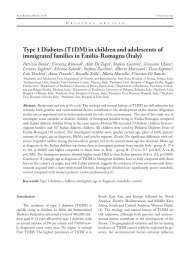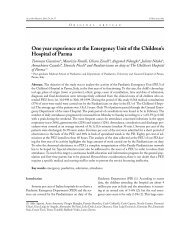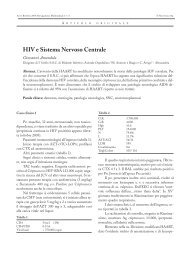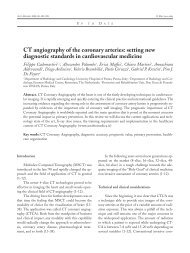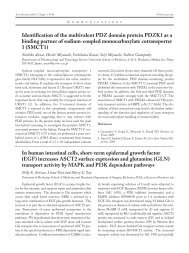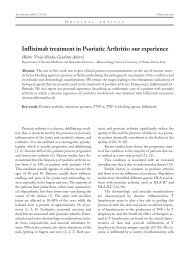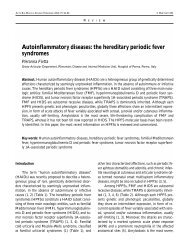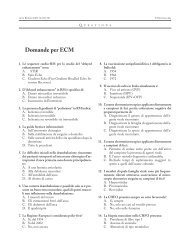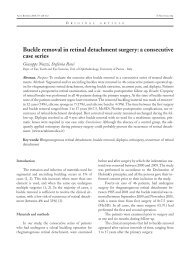Amniotic fluid index versus largest vertical pocket in the pre- diction ...
Amniotic fluid index versus largest vertical pocket in the pre- diction ...
Amniotic fluid index versus largest vertical pocket in the pre- diction ...
You also want an ePaper? Increase the reach of your titles
YUMPU automatically turns print PDFs into web optimized ePapers that Google loves.
ACTA BIO MEDICA ATENEO PARMENSE 2004; 75; Suppl. 1: 67-70 © Mattioli 1885C O N F E R E N C E R E P O R T<strong>Amniotic</strong> <strong>fluid</strong> <strong><strong>in</strong>dex</strong> <strong>versus</strong> <strong>largest</strong> <strong>vertical</strong> <strong>pocket</strong> <strong>in</strong> <strong>the</strong> <strong>pre</strong><strong>diction</strong>of per<strong>in</strong>atal outcome <strong>in</strong> post-term <strong>pre</strong>gnanciesCarla Verrotti, Laura Bedocchi, Giovanni Piantelli, Davide Cavallotti, Stefania Fieni,Dandolo Gramell<strong>in</strong>iDepartment of Obstetrics and Gynecology, University of ParmaAbstract. We studied a cohort of 41 s<strong>in</strong>gleton <strong>pre</strong>gnancies <strong>in</strong>duced at term with prostagland<strong>in</strong>s and, whennecessary, oxytoc<strong>in</strong>. We evaluated with ultrasound <strong>the</strong> amniotic <strong>fluid</strong> <strong><strong>in</strong>dex</strong> (AFI) and <strong>the</strong> <strong>largest</strong> <strong>vertical</strong><strong>pocket</strong> (LVP), at least 2 days before <strong>the</strong> delivery, to compare <strong>the</strong> sonographic measurement of amniotic <strong>fluid</strong>with fetal distress and per<strong>in</strong>atal outcome. We analysed <strong>the</strong> <strong>in</strong>cidence of fetal distress us<strong>in</strong>g <strong>in</strong>trapartummonitor<strong>in</strong>g of fetal heart rate, consider<strong>in</strong>g <strong>the</strong> absence of variability, <strong>the</strong> <strong>pre</strong>sence of persistent severe variableand/or late decelerations. The oligohydramnios group, <strong>in</strong>dipendently by ultrasound <strong><strong>in</strong>dex</strong>, showed <strong>the</strong>same <strong>in</strong>cidence of abnormal FHR, and rate of Cesarean section for fetal distress as <strong>the</strong> group with normalamniotic <strong>fluid</strong>. In conclusion <strong>the</strong>re is no significant difference between <strong>the</strong> group of patients with oligohydramniosand <strong>the</strong> one with normal amniotic <strong>fluid</strong> regard<strong>in</strong>g <strong>the</strong> per<strong>in</strong>atal outcome <strong>in</strong> <strong>in</strong>duced labor.Key words: Oligohydramnios, post-term <strong>pre</strong>gnancy, amniotic <strong>fluid</strong> <strong><strong>in</strong>dex</strong>, <strong>largest</strong> <strong>vertical</strong> <strong>pocket</strong>, ultrasoundIntroductionThe mechanisms that cause a decrease <strong>in</strong> amniotic<strong>fluid</strong> volume (AFV) <strong>in</strong> postterm <strong>pre</strong>gnancies arenot completely understood: it is supposed to be a decreasedplacental function and/or a reduction of fetalur<strong>in</strong>e production due to a decreased fetal renal flow(1).In <strong>pre</strong>gnancies beyond 40 weeks of gestationAFV is an important <strong>pre</strong>dictor of fetal well-be<strong>in</strong>g and<strong>the</strong> <strong>pre</strong>sence of oligohydramnios was usually associatedwith an <strong>in</strong>creased risk of fetal heart abnormalities,meconium-sta<strong>in</strong>ed amniotic <strong>fluid</strong> and cesarean sectionsfor fetal distress (2).As a result, <strong>the</strong> sonographic detection of AFV hasbeen used <strong>in</strong> <strong>the</strong> ante-partum monitor<strong>in</strong>g of postterm<strong>pre</strong>gnancies.In 1980 Mann<strong>in</strong>g suggested measur<strong>in</strong>g <strong>the</strong> s<strong>in</strong>gledeepest <strong>pocket</strong> of amniotic <strong>fluid</strong> and def<strong>in</strong>ed oligohydramniosas <strong>the</strong> <strong>pre</strong>sence of one s<strong>in</strong>gle <strong>pocket</strong> with adepth
68 C. Verrotti, L. Bedocchi, G. Piantelli, D. Cavallotti, S. Fieni, D. Gramell<strong>in</strong>ime authors have proposed to treat <strong>pre</strong>gnancies complicatedby oligohydramnios at term with prophylacticamnio<strong>in</strong>fusion to relive umbilical cord com<strong>pre</strong>ssiondur<strong>in</strong>g labour (7, 8). Infact, some data show that womenwith oligohydramnios, who receive <strong>in</strong>trapartumamnio<strong>in</strong>fusion, had a lower <strong>in</strong>cidence of Cesarean sectionsfor FHR abnormalities (9).There is no consent <strong>in</strong> literature regard<strong>in</strong>g <strong>the</strong>real effectiveness of prophylactic amnio<strong>in</strong>fusion because<strong>the</strong>re are o<strong>the</strong>r important studies demonstrat<strong>in</strong>gthat amnio<strong>in</strong>fusion should be reserved for labour<strong>in</strong>gpatients with variable FHR deceleration, ra<strong>the</strong>r thanfor all patients with oligohydramnios.This was alsoconfirmed by Hofmeyr <strong>in</strong> a Cochrane review of <strong>the</strong>litterature (10).Aim of <strong>the</strong> studyThe purpose of this study was to <strong>in</strong>vestigate if <strong>the</strong>per<strong>in</strong>atal outcome varies <strong>in</strong> <strong>in</strong>duced <strong>pre</strong>gnancies <strong>in</strong>function of normal or abnormal amniotic <strong>fluid</strong> volumemeasured us<strong>in</strong>g <strong>the</strong> amniotic <strong>fluid</strong> <strong><strong>in</strong>dex</strong> (AFI) and<strong>largest</strong> <strong>vertical</strong> <strong>pocket</strong> (LVP).MethodsWe exam<strong>in</strong>ed 41 s<strong>in</strong>gleton <strong>pre</strong>gnancies at term(mean gestational age of 40.5 weeks, range 37-41.6weeks) at <strong>the</strong> University of Parma between May andAugust 2003. All were uncomplicated <strong>pre</strong>gnancies,without any severe maternal disease. All <strong>the</strong> patientswere studied dur<strong>in</strong>g <strong>pre</strong>gnancy with ultrasound for <strong>the</strong>detection of major fetal abnormalities and we excludedfrom our study all <strong>the</strong> <strong>pre</strong>gnancy with fetal anomalies.All <strong>the</strong> patients were subjected to an ultrasoundscan for <strong>the</strong> determ<strong>in</strong>ation of both <strong>the</strong> AFI and <strong>the</strong>LVP at least 2 days before <strong>the</strong> delivery.All <strong>the</strong> deliveries were <strong>in</strong>duced us<strong>in</strong>g local applicationof prostagland<strong>in</strong> E 2 for cervical ripen<strong>in</strong>g and, ifnecessary, augmentation with <strong>in</strong>fusion of oxytoc<strong>in</strong>.The <strong>in</strong>dications for <strong>in</strong>duction of labour were: reductionof amniotic <strong>fluid</strong> volume, post-term <strong>pre</strong>gnancy,<strong>pre</strong>venction of fetal macrosomia, mild <strong>pre</strong>gnancy-<strong>in</strong>ducedhypertension.We divided our patients <strong>in</strong>to three groups: GroupA with AFI ≤5 cm and LVP ≤2 cm , Group B withAFI ≤5 cm but LVP >2 cm and Group C with AFI >5cm and LVP >2 cm. Among <strong>the</strong> three groups we haveevaluated <strong>the</strong> <strong>in</strong>cidence of fetal distress us<strong>in</strong>g <strong>in</strong>trapartummonitor<strong>in</strong>g of fetal heart rate, consider<strong>in</strong>g <strong>the</strong> absenceof variability, <strong>the</strong> <strong>pre</strong>sence of persistent severevariable and/or late decelerations (11, 12).We also studied <strong>the</strong> <strong>in</strong>cidence of vag<strong>in</strong>al delivery<strong>versus</strong> Cesarean section and <strong>the</strong> Apgar scores at 1 st and5 th m<strong>in</strong>ute after birth.For <strong>the</strong> evaluation of adverse per<strong>in</strong>atal outcome astatistical analysis us<strong>in</strong>g T-student test, Chi-Square, Fisher’sexact test was performed.ResultsThe <strong>in</strong>cidence of oligohydramnios, considered asAFI
<strong>Amniotic</strong> <strong>fluid</strong> <strong><strong>in</strong>dex</strong> <strong>versus</strong> <strong>largest</strong> <strong>vertical</strong> <strong>pocket</strong> <strong>in</strong> <strong>the</strong> <strong>pre</strong><strong>diction</strong> of per<strong>in</strong>atal outcome <strong>in</strong> post-term <strong>pre</strong>gnancies69Table 1. Per<strong>in</strong>atal outcome <strong>in</strong> relation to amniotic <strong>fluid</strong> volume assessed by amniotic <strong>fluid</strong> <strong><strong>in</strong>dex</strong> (AFI) and <strong>largest</strong> <strong>vertical</strong> <strong>pocket</strong>(LVP)41 patients Group A Group B Group C(AFI ≤5cm, LVP ≤2 cm) (AFI ≤5cm, LVP >2 cm) (AFI >5 cm, LVP >2 cm)Gestational age 40wks+6days 39wks+3days 40wks+3daysAFI 3. 55 cm 4.08 cm 12.3 cm *LVP 1.7 cm ** 2.3 cm 4.2 cm ***Non reassur<strong>in</strong>g fetal heart rate 14% 0% 15%Cesarean section for fetal distress 0% 0% 7%Apgar score - 1 st m<strong>in</strong>
70 C. Verrotti, L. Bedocchi, G. Piantelli, D. Cavallotti, S. Fieni, D. Gramell<strong>in</strong>i6. Magann EF, et al. <strong>Amniotic</strong> <strong>fluid</strong> <strong><strong>in</strong>dex</strong> and s<strong>in</strong>gle deepest<strong>pocket</strong> : weak <strong>in</strong>dicators of abnormal amniotic volumes.Obstet Gynecol 2000; 96(5 Pt 1): 737-40.7. Pitt C, Sanchez-Ramos L, Kaunitz AM, Gaudier F.Prophylactic amnio<strong>in</strong>fusion for <strong>in</strong>trapartum oligohydramnios:a meta-analysis of randomized controlled trials. ObstetGynecol 2000; 96: 861-6.8. Am<strong>in</strong> AF, Mohammed MS, Sayed GH, Abdel-Razik S.Prophylactic transcervical amnio<strong>in</strong>fusion <strong>in</strong> labour<strong>in</strong>g womenwith oligohydramnios. Int Gynecol Obstet 2003; 81 (2): 183-9.9. Ogundipe OA, Spong CY, Ross MG. Prophylactic amnio<strong>in</strong>fusionfor oligohydramnios: a revaluation. Obstet Gynecol1994; 84 (4): 544-8.10. Hofmeyr GJ. Prophylactic <strong>versus</strong> <strong>the</strong>rapeutic amnio<strong>in</strong>fusionfor oligohydramnios <strong>in</strong> labour. Cochrane Database SystRev 2000; (2): CD000176.11. Ra<strong>in</strong>ford M, Adair R, Scialli AR, Ghid<strong>in</strong>i A, Spong CY.<strong>Amniotic</strong> <strong>fluid</strong> <strong><strong>in</strong>dex</strong> <strong>in</strong> <strong>the</strong> uncomplicated term <strong>pre</strong>gnancy.Pre<strong>diction</strong> of outcome. J Reprod Med 2001; 46 (6):589-92.12. Locatelli A, Vergani P, Toso L, Verderio M, Pezzullo JC,Ghid<strong>in</strong>i A. Per<strong>in</strong>atal outcome associated with oligohydramnios<strong>in</strong> uncomplicated term <strong>pre</strong>gnancies. Arch GynecolObstet 2004; 269 (2): 130-3.Correspondence: Carla VerrottiTel: 0039 0521 702436Fax: 0039 0521 702542E-mail: carla.verrotti@libero.it


